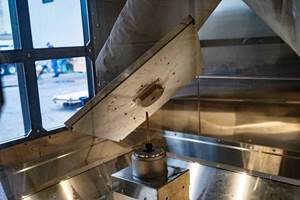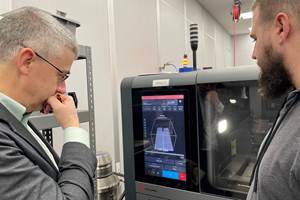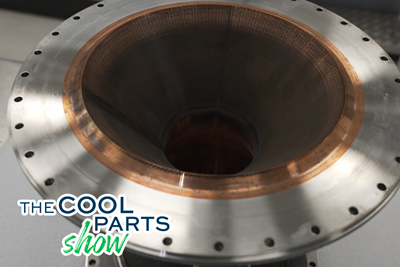“The challenge is the tedium,” says Joseph Sims, director of advanced manufacturing for Quadrus Corp., as he describes the work his company’s team members do to clean laser powder bed fusion machines for material changeover.

Here is a tungsten rhenium throat insert for a solid-fuel missile. (This one has a piece cut out for metallurgical evaluation.) Additive manufacturing will reduce the lead time for making this part by many months. Quadrus exists to explore and develop opportunities such as this. “We are building old parts in new ways,” says Advanced Manufacturing Director Joseph Sims.
The work is necessary to ensure there is zero remaining powder of a previous material in the machine before beginning a build with a new material. The cleaning requires technical skill and knowledge of the machine. It also requires disciplined focus and patience.
“Removing the first 90% of material takes a couple hours, then it takes one week to get the remaining 10%,” he says. Each cleaning involves vacuum equipment and a significant amount of disassembly and reassembly of the machine, along with “about a half gallon each of Windex and Simple Green, plus a few thousand Q Tips,” Sims says. “Our standard used to be that the machine needs to be clean enough to eat off of. That’s not quite enough. The standard now is, before we will add new material, the machine needs to be clean enough to lick.”

Cleaning laser powder bed fusion machines is a vital area of expertise. The company routinely transitions between unusual alloys. Because cleaning entails machine disassembly and reassembly, the cleaning expertise equates to machine expertise. (The machine name “La Forge” is visible at upper left. Quadrus names its AM machines after characters from Star Trek: The Next Generation.)
Strange as that image might be, the standard is no exaggeration. The result of the persistent level of cleaning effort is 10-year-old additive manufacturing machines in this facility at which visitors marvel (I did), because the machines appear to be brand new. The decade-old Concept Laser machines, from before Concept Laser became part of GE Additive (now Colibrium Additive), look so fresh and new that the machines appear to have been freshly delivered by a time machine.

A selection of the company’s LPBF machines. Quadrus has remained standardized on Concept Laser equipment, both before and after that company's acquisition. Because of the frequency and thoroughness of machine cleaning, older machines are difficult to distinguish from newer ones by cosmetic appearance.
Again, it is all necessary. Quadrus is a company devoted to exploring not the geometric freedom of additive manufacturing but instead what is possibly the more compelling area of design freedom: the chance to quickly and cost-effectively work with some of the most challenging materials used in production. Many of the parts Quadrus takes on are Department of Defense components that historically have been very expensive, but now, through AM, have the chance to become much less so. Certain NASA parts including rocket nozzles made of 3D-printable copper alloys fit this description as well. Quadrus’ role in these cases is to develop the new process allowing AM technology to produce an existing high-value part more cheaply. “We are building old parts in new ways,” Sims says.
Perhaps the most notable area of success has been the company’s work in tungsten rhenium for missile components. One part made of this material is the missile’s throat insert. Arguably the most critical part of the missile’s propulsion, the insert constrains the flow of exhaust to its minimum cross section to accelerate that flow to Mach 1. The part must resist erosion of its diameter at operating temperatures of 3,000 to 4,000°F, with no possibility of applying a cooling system to bring that temperature down. This is because missiles, by their nature, have to be engineered so they can sit for decades before being suddenly put into use. That means they are propelled using solid fuel, not liquid — and the lack of any access to liquid within the system eliminates any chance to circulate fluid for cooling. Tungsten rhenium withstands the heat, but manufacturing with this refractory alloy has generally involved either powder metal molding or arc casting, both processes that are performed by specialized suppliers apt to require many months of lead time. The AM process Quadrus has been able to develop will allow a tungsten rhenium component to be obtained within a lead time of a few weeks at most.

U.S. Navy pathfinder components made of niobium alloy C103 are another example of old parts made in new ways. Assembly consolidation has reduced the number of welds in these components, which were designed in the 1970s, and redesigning the components for additive manufacturing will streamline their production even further. The chance to shift these components to AM will save cost and lead time while helping with the life extension of the system in which these components are employed.
Process development like this is Quadrus’ work. The company consists in large part of propulsion engineers. “We are an engineering firm that got into additive,” Sims says, out of the realization that AM brings significant new freedom to work with challenging metals. “We are not a manufacturer such as a machine shop that got into AM,” he explains. The engineering is the aim, not short-run prototyping. “We are not going to become a job shop,” he says.

Another Navy pathfinder component not seen in the preceding photo: metal bellows. Quadrus learned about AM’s potential for flexible bellows through an episode of The Cool Parts Show about redesigning bellows for production via LPBF. To 3D print flexible bellows that precisely match the operation of the Navy parts made through forming, Quadrus needs to match these parts’ stiffness, which means getting exactly the right wall thickness in the AM components. These test pieces are aimed at realizing that. They are part of an experiment measuring as-built walls in different parameter sets against the modeled wall thickness.
Except, here is the thing: In terms of switching from one metal AM application to the next, Quadrus actually does perform effectively as a job shop. That is, becoming responsive enough to take on various material-engineering challenges as they come has driven the company to develop a process that is adaptable to material changes to the same extent that an efficient job shop is adaptable to, say, part number change. In production AM, many facilities do all they can to avoid material changeover. Dedicating AM machines by material is very common. But at Quadrus, by contrast, the machines are labeled by material using removable magnets, because the material changes all the time. And this material change, along with material quality control in general, must be so thorough as to leave no chance that variability in powder or the remains of a previous build can compromise confidence in the work.
How is this done? For responsiveness in meeting demanding requirements in an ever-changing mix of materials, the principles Quadrus follows are straightforward. Plus, some of its practices are surprisingly practical — one of the tools is coffee canisters.
Few powder bed fusion users must change material as routinely as Quadrus. For insight into how to systemize this changeover when it does occur, what follows are some of the measures this expert in material change employs.
1. Material Validation In-House
In its development of its additive manufacturing procedures and system, Quadrus was quick to arrive at a conclusion that many AM part producers have also found. Namely: The quality and consistency of 3D printed parts is only as good as the quality and consistency of incoming powder — and so this latter quality and consistency have to be assured.

Assuring the consistency of incoming powder is vital for process control. A sequence of evaluation tools in the powder lab measures (left to right) density, spreadability, size distribution and flowability.
“Build parameters at the machine are what we control,” Sims says. A quality lab employing microscopy and tensile testing evaluates the outcomes of these parameter choices. “The material coming in is what we have to account for.” For this, an entirely separate lab evaluates powder density, particle size distribution, spreadability and flowability to assure these properties repeat from batch to batch of the same material.
Powder history is another meaningful factor. “We have had to develop our own set of criteria for when powder has been used in enough builds to see property change,” Sims says. A current, ongoing effort is focused on fundamental measurements related to density and tensile properties, among other properties, to ensure that powder service life limits are identified.
2. Storage With Environmental Control
Quadrus is a power user of the Airscape Coffee Canister by Planetary Design, as surprising as this application of the canister might be to its maker. The containers from industrial powder suppliers are not all alike in their sealing of the powder, Sims says. The Airscape canister is designed to prevent oxygen exposure to coffee, which makes it effective performing the same role for powder metal alloy. Quadrus has hundreds of these 64-ounce canisters in use in its facility.

Quadrus’ Joseph Sims says the company found an effective powder metal storage system in canisters intended for storing coffee. Quadrus uses Airscape sealed canisters from Planetary Design as its standard for powder storage.
Plus, in a belt-and-suspenders approach, Quadrus also places oxygen and moisture absorbers into each canister along with the powder. When working to develop processes for challenging materials, it is difficult to predict what factor or exposure might have a meaningful effect on the capacity of the material to form, say, thin walls or crack-free solid sections. Therefore, “I assume everything we do, or everything the material is subjected to, might be a big deal,” Sims says.
3. Build Plate Organization
Build plates are also engineered and systemized. The tracking matrix seen in the first photo helps to organize the build plate library, which consists of different sizes, designs and materials for different machines and applications.
Another factor to which the material is subjected is the build plate. For Quadrus, each of these plates is far from a commodity item. Different build plate designs accommodate different part build heights and location references, and build plate materials including aluminum, Inconel, steels, titanium and tungsten all assure optimum welding to the 3D printed part. This array demands a management system, so Quadrus has a build plate library for organizing this hardware, along with a visual matrix for tracking plates through different machines and through EDM, heat treating, part machining and plate resurfacing.
4. Vertical Integration of Postprocessing
Postprocessing steps represent an additional area of investment and learning — part machining in particular. Becoming an expert in 3D printing refractory alloys also means developing expertise in the downstream steps. “There aren’t many shops that know about machining these materials,” Sims says. Finishing the tungsten rhenium missile components sometimes requires fine machining to meet critical tolerances of the part, but even these light cuts are challenging because of the poor machinability of the metal. Quadrus performs machining of parts such as these on a DA300 five-axis machining center from Makino, a higher-end machine tool engineered for rigid cutting. The investment assures continued process consistency through to postprocessing, so the value created in the 3D printing process is not lost during machining.

Additive manufacturing of challenging alloys combines expertise in 3D printing these materials and in machining them. Machining alloys such as tungsten rhenium is done on this rigid machining center from Makino. Visible in the background, past me, is another example of in-house capability: a controlled atmosphere furnace for heat treating from Across International.
Or during heat treating, he says, which is another in-house capability. Quadrus employs furnaces from Lucifer and Across International, the latter a vacuum furnace for materials requiring ongoing control over oxygen exposure. Yet even with all of this, full integration of postprocessing steps is impractical, so the company supplements its in-house control with carefully cultivated supplier relationships. Heat treating tungsten rhenium requires this. “Refractories are beyond what we can do in terms of heat treating difficulty,” Sims says. “We’ve found just one vendor that can achieve and hold the temperatures we need.”
5. Cleaning Expertise
This, again, is a core competency. Quadrus is a process engineering company, still pursuing its first manufacturing contract for producing recurring parts. Laser powder bed fusion machines therefore cannot be dedicated by material; they must be ready for different materials. That makes cleaning machines a vital area of expertise.
Sims recounts one case in which a customer hypothesized that a variance it saw in parts from Quadrus might have been the result of material contamination. Even as an idle guess, that could not be allowed to stand. Quadrus invested in a weeks-long study of the incident to prove that material contamination could be eliminated as a potential cause. “We do not want a case to be falsely made for why not to change material in the machines,” he says.
The machine cleaning expertise is, essentially, machine expertise. All the company’s AM machines are from Concept Laser, spanning both before and after GE Additive. Quadrus employees are masters at disassembling and reassembling these machines.
Sims says that expertise will soon prove to have a valuable side benefit in terms of equipment availability. The very oldest Concept Laser machines are now reaching the end of their product life span, and soon they will no longer be actively supported by their OEM. As a result, he expects many of these machines to come onto the market at a reduced price. This will be a windfall for Quadrus, he says. Because the company’s team members know these machines inside and out, they know exactly how to service them. For any first-generation Concept machine returning to the market, they will know exactly how to get it performing like new.
Related Content
Video: 5" Diameter Navy Artillery Rounds Made Through Robot Directed Energy Deposition (DED) Instead of Forging
Big Metal Additive conceives additive manufacturing production factory making hundreds of Navy projectile housings per day.
Read MoreThe Cold Spray Solution to the Casting, Forging Supply Chains
Startup HAMR Industries performs additive manufacturing work at Neighborhood 91 that provides an alternative to traditional casting and forging. Success so far has led to redefining the limits of its additive equipment.
Read MoreNeighborhood 91 Expands, With Metal Powder Works and HAMR Now Open
Ribbon cuttings for the Pittsburgh campus's newest tenants coincided with the announcement that a DOD-funded resilient manufacturing program will also be developed at the site.
Read MoreFreeform: Binder Jetting Does Not Change the Basics of Manufacturing
Rather than adapting production methodologies to additive manufacturing, this Pennsylvania contract manufacturer adapts AM to production methodologies. In general, this starts with conversation.
Read MoreRead Next
Additive Manufacturing for Defense: Targeting Qualification
Targeting qualification in additive manufacturing for the defense industry means ensuring repeatability as well as reliability as there is much at stake, including human lives. Certain requirements therefore must be met by weapons systems used by the defense industry.
Read MoreDefense Department Looks to Additive Manufacturing to Propel Hypersonic Systems
The DoD is requesting prototype solutions for its Growing Additive Manufacturing Maturity for Airbreathing Hypersonics (GAMMA-H) challenge as part of the department’s ongoing efforts to expand manufacturing processes for intricate hypersonic weapons parts.
Read More3D Printed NASA Thrust Chamber Assembly Combines Two Metal Processes: The Cool Parts Show #71
Laser powder bed fusion and directed energy deposition combine for an integrated multimetal rocket propulsion system that will save cost and time for NASA. The Cool Parts Show visits NASA’s Marshall Space Flight Center.
Read More























